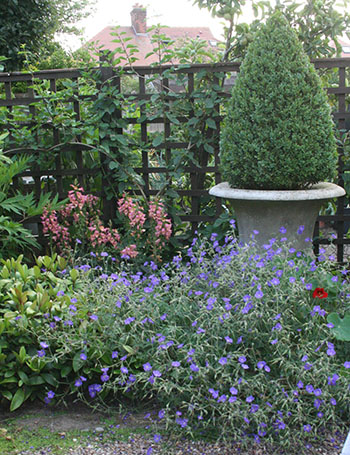 Sweet pea Sugar and Spice in hanging basket
Sweet pea Sugar and Spice in hanging basket
by our gardening expert PETER SURRIDGE
IF YOU have been stuck at home looking at the same views in your garden for weeks, you become keenly aware of what looks good and what doesn’t.
The best plants might not be in the best places, focal points could deserve a more eye-catching feature and blots on the landscape probably need moving or hiding.
It may not be easy to buy the plants you need immediately but you can make an action plan to start when coronavirus restrictions are lifted.
Check these questions. The answers could help you to make even a small garden great.
 Is there more potential for new views and focal points? Paths or lawns look even better if they direct the eye to a focal point such as a colourfully-planted tub, an ornament like an urn, a statuette or a small specimen tree.
Is there more potential for new views and focal points? Paths or lawns look even better if they direct the eye to a focal point such as a colourfully-planted tub, an ornament like an urn, a statuette or a small specimen tree.
Specimen trees are among the loveliest garden sights, especially one is attractive at different times of year, maybe a flowering cherry like Prunus serrula, with white spring flowers and gleaming, mahognany-coloured bark which peels in late summer; the paperbark maple, Acer griseum, with crimson autumn leaves and peeling bark; or an ornamental hawthorn, rowan or crab apple. All have scented spring blossom and colourful autumn fruits. Among the crab apples choose from the varieties ‘Golden Hornet’ (bright lime-green fruits), ‘John Downie’ (red and yellow fruits) or the weeping ‘Red Jade’ (crimson fruits).
- Is your small garden spoiled by unsightly views beyond your boundary? It could be transformed by planting a small tree or climbers which screen the eyesore from the most important viewing positions such as a patio, a kitchen window or your favourite garden seat.
- On the subject of seats – the most important piece of garden furniture – is yours inviting to look at as well as from? Seats that are both eye-catching and comfortable can be expensive but worth it because they will give you pleasure for years.
 What about gloomy walls or fences? They can be converted by trellis adorned with climbing plants. Try any of the quick-growing scramblers. Some of the most effective are clematis such as Clematis montana, with a mass display of small white or pink flowers in spring, the spectacular gold-variegated ivies Goldheart or Sulphurea (aka Paddy’s Pride), the evergreen honeysuckle, Lonicera japonica, or the variety Lonicera Aureoreticulata which has unusual yellow-veined foliage. Avoid the Russian vine, Polygnum baldschuanicum, which is overwhelmingly rampant.
What about gloomy walls or fences? They can be converted by trellis adorned with climbing plants. Try any of the quick-growing scramblers. Some of the most effective are clematis such as Clematis montana, with a mass display of small white or pink flowers in spring, the spectacular gold-variegated ivies Goldheart or Sulphurea (aka Paddy’s Pride), the evergreen honeysuckle, Lonicera japonica, or the variety Lonicera Aureoreticulata which has unusual yellow-veined foliage. Avoid the Russian vine, Polygnum baldschuanicum, which is overwhelmingly rampant.- Could you add a small water feature? Water can be calming yet its movement and reflection catch the eye all year while rockwork or plants like irises enhance the scene.
- Some design blunders are difficult to correct. A classic design clanger is a shed sited down the garden where it dominates the view – and might also be too far from the house. Again, trellis and climbers can transform the outlook.
PLANT OF THE SEASON: Sweet Pea
SWEET peas evoke summer more than most other flowers.
From the end of June they add scent and elegance to the garden or patio and provide successional blooms for the house. They might seem delicate but are not. They can be sown in a greenhouse in November or December for the earliest flowers or as late as March, in the ground where they are to flower.
Their colours range from white through shades of cream, red, pink, blue and purple while there are types for many purposes – long-stemmed for cutting, tall for climbing fences and trailing for hanging baskets.
An authority on sweet peas, Charles Unwin, giving the first broadcast talk about sweet peas on “the wireless” in 1923, said: “The sweet pea is one of the very easiest, most adaptable, and most reasonable flowers we have and can be successfully grown by anyone. Don’t be frightened by elaborate cultural instructions for, if you can grow eating peas or runner beans, you can grow sweet peas.”
The plant was unheard of in Britain until the 17th century – the earliest were sent by a Sicilian monk, Franciscus Cupani, in 1699, and were thought to have originated on Malta. This form with burgundy and purple flowers, small but exquisitely scented, is still known as Cupani and is available as seed.
In the 1880s, Henry Eckford improved and popularised the flower by making the bloom larger and shapelier and introducing a wider range of colours. The little Shropshire town of Wem, where he carried out his work, stages a regular sweet pea show in his honour.
Natural variations in the flowers were developed by William Unwin, Charles’s father, by Eckford and by Silas Cole, head gardener at Althorp Park, the Spencer family home in Northamptonshire. Cole saved seeds from his own selection of plants and introduced the variety Countess Spencer. From this name the term ‘Spencer sweet pea’ was derived and remains popular to this day.

